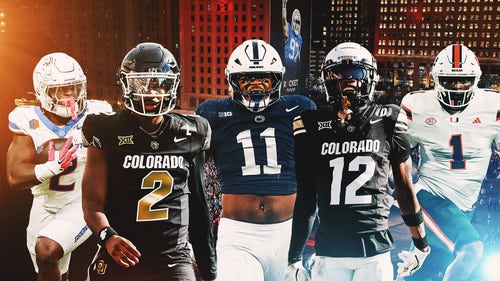
How Ravens revamped offense to keep Lamar Jackson healthy, win in playoffs
When the Ravens decided to revamp their offense after last season, the skeptics and naysayers wondered if Lamar Jackson could transition from an option-based attack to a traditional offense without losing the superpowers that made him the league MVP in 2019.
Head coach John Harbaugh and new offensive coordinator Todd Monken promised a "player-driven" system built around the strengths of the Ravens' offensive personnel. Still, it was hard to envision how Monken, a former college offensive playcaller, would create a scheme that allowed Jackson to continue to produce big plays as a runner, while improving his overall efficiency and effectiveness as a passer.
Moreover, the jury was still out on whether Jackson could elevate his game as a dual-threat playmaker while protecting himself from the big hits that prematurely ended his 2021 and 2022 seasons.
As an electric runner with exceptional speed, quickness and burst, Jackson posted back-to-back 1,000-yard seasons as the lead runner in former OC Greg Roman's run-heavy attack. The 6-foot-2, 215-pound QB teased and tormented opponents on designed quarterback runs, particularly quarterback powers, and counters, with Jackson running behind pulling linemen and tight ends between the tackles.
The offense was old-school, a modernized version of the single wing that lured extra defenders into the box with condensed formations, unbalanced alignments and various pre-snap shifts and motions. Though the Ravens routinely bludgeoned plus-one boxes with downhill runs sparked by the playmaking quarterback, the offense seemingly bogged down in the playoffs when opponents would sell out to stop the run. The Ravens struggled against the blitz, particularly "zero pressures" that attacked Jackson with six or seven defenders from all angles.
Without effective counters to the blitz-heavy tactics and overloaded boxes, the Ravens were routinely one-and-done in the playoffs, leaving Baltimore coaches, players and the fans frustrated. With Jackson eventually inking a five-year, $260 million deal ($52 million annually) that keeps him in Baltimore through his early 30s, the Ravens needed to update the offense to produce more playoff wins and preserve the QB1 for the long haul.
With Monken, the Ravens have implemented a multi-faceted system that features a mix of spread formations with quick-rhythm concepts and RPOs and heavy personnel packages with downhill runs dotting the menu.
"I think the game has changed," said Monken at his introductory press conference last year. "The game has become more of a space game — using all 53-and-a-third yards and using the width and depth of the field, using space players and your skill players. I think that's changed. Years ago, maybe it was inside-zone and run-duo downhill. Now, it's utilizing athletic quarterbacks.
"At one time, it was taller pocket passers, and now you're seeing more shorter, athletic players. The game has changed in terms of using their athleticism, what they bring to the table. Because the game is about space. It's about being explosive. How do you create explosives? Well, part of it is creating space."
The increased utilization of spread formations by the Ravens has enabled Monken to employ Jackson as a scrambler, not as a pseudo-tailback on power runs. The subtle shift has allowed the Ravens to maintain their stellar rushing production (No. 1-ranked rush offense for the third time in Jackson's five years as a full-time starter) without running into the plus-one boxes that would occasionally stymie the offense. In addition, the scrambles force defenders to make one-on-one tackles in space, leading to more big-play chances on the ground.
With the Ravens occasionally attaching quick routes to designed quarterback runs, including Jackson's 15-yard rushing score in the AFC divisional round, the former MVP can take advantage of the space created by spread formations.
The Ravens have also expanded the playbook to feature more under-center plays with Jackson running a bootleg or carrying out a fake following a handoff. By utilizing old-school plays with the quarterback under center, the Ravens make it harder for defenders to find the football with the QB and running back playing the shell game in the backfield. With the threat of the bootleg forcing backside defenders to stay at home instead of aggressively pursuing the ball, the Ravens can use the threat of Jackson running to control the defense without putting the veteran in harm's way.
As the 27-year-old Jackson inches closer to 30, the increased utilization of bootlegs and scrambles instead of designed quarterback runs will help him avoid the big hits that could lead to bumps and bruises that previously forced him to the sidelines.
To address the Ravens' passing woes, the team has surrounded him with four former first-rounders on the perimeter, with Odell Beckham Jr., Rashod Bateman, Zay Flowers and Nelson Agholor on the field in four-receiver sets. Though Mark Andrews and Isaiah Likely were selected outside of Round 1, Baltimore's dynamic duo at tight end creates matchup problems for defenses that lack ultra-athletic linebackers or safeties.
With Monken willing to build around the strengths of an upgraded pass-catching crew and a quarterback specializing in throwing in-breaking routes at every level, the Ravens terrorize opponents between the numbers. From three-step slants to shallow crossing routes to deep overs and square-ins, Baltimore's route tree perfectly matches Jackson's hot spots as a thrower.
Given those subtle adjustments, it is not surprising to see Jackson posting career bests in completion percentage (67.2%), pass yards (3,678) and yards per attempt (8.0) with quarterback-friendly play designs built around his game.
[READ MORE: Why Ravens QB Lamar Jackson will be a huge challenge for Chiefs defense]
It is precisely what Monken said he would do when he took the job.
"It's just football," Monken said back then. "We'll cater to what he knows, and play. It's like any player: The more time you spend with them, the more comfortable they get with any system or relationship. That's a big part of it, and there's a big part of that relationship from a quarterback-coordinator, playcaller, position coach where they're comfortable and there's a trust."
Considering how Baltimore has rolled through the AFC with a red-hot quarterback playing at an MVP level, team-builders should pay close attention to how the Ravens revamped the playbook and helped their QB1 evolve and thrive as a big-money player.
Bucky Brooks is an NFL analyst for FOX Sports. He also breaks down the game for NFL Network and as a cohost of the "Moving the Sticks" podcast. Follow him on Twitter @BuckyBrooks.












